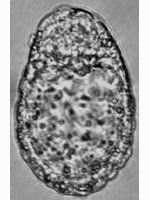WEB FOCUS
25 years of Embryonic Stem Cells

In this focus
This year marks the 25th anniversary of two papers reporting the first isolation of mouse ES cells. The first impact of the mouse ES papers was enabling targeted gene knock outs in mice, a technology which has revolutionized mouse genetics and developmental biology. It took seventeen more years for Jamie Thomson to isolate ES cells from human embryos, one of the great milestones in human biomedical research.
Isolation of ES cells was built on a body of work on teratocarcinomas, a rare and bizarre type of tumor that contains stem cells. Efforts to isolate and culture these stem cells, and study their differentiation into adult cell types, laid the groundwork from which ES cell research emerged.
To mark this anniversary, Nature is featuring papers that show the progression of ES cell research, as well as a perspective by Davor Solter, recapitulating this fascinating history. We hope you find it a compelling story.
Image: Jennifer Nichols and Jose da Silva
Current research
LETTER
Nanog promotes transfer of pluripotency after cell fusion
José Silva, Ian Chambers, Steven Pollard & Austin Smith
Nature 441, 997-1001 (22 June 2006) doi:10.1038/nature04914
Abstract | Full Text | PDF | Supplementary Information
ARTICLE
Dissecting self-renewal in stem cells with RNA interference
N. Ivanova, et al.
Nature; published online 11 June 2006. doi:10.1038/nature04915
Abstract | Full Text | PDF | Supplementary Information
Top of page
Web links
- Making Stem Cells web focus
- Riches in Stem Cell Niches web focus
- Stem Cells in focus
- Woo Suk Hwang special
- International Society for Stem Cell Research
- Institute for Stem Cell Research
- Harvard Stem Cell Institute
- National Institutes of Health Stem Cell information page
Archive
PERSPECTIVE
From teratocarcinomas to embryonic stem cells and beyond: a history of embryonic stem cell research
Davor Solter
Nature Reviews Genetics 7, 319-327 (April 2006) doi:10.1038/nrg1827
Teratocarcinomas
LETTERS TO NATURE
Extrauterine growth of mouse egg-cylinders results in malignant teratoma
D. Solter, N. Skreb & I. Damjanov
Nature 227, 503-504 (01 August 1970) doi:10.1038/227503a0
LETTER
The Ter mutation in the dead end gene causes germ cell loss and testicular germ cell tumours
Kirsten K. Youngren et al.
Nature 435, 360-364 (19 May 2005) doi:10.1038/nature03595
Abstract | Full Text | PDF | Supplementary Information
LETTER
Isolation of a human teratoma cell line which expresses F9 antigen
B. Hogan et al.
Nature 270, 515-518 (08 December 1977) doi:10.1038/270515a0
Embryonal carcinoma cells
LETTER
Stage-specific embryonic antigen involves alpha 1 goes to 3 fucosylated type 2 blood group chains
H. C. Gooi, T. Feizi, A. Kapadia, B. B. Knowles, D. Solter & M. J. Evans
Nature 292, 156-158 (09 July 1981) doi:10.1038/292156a0
LETTERS TO NATURE
Sequential activation of HOX2 homeobox genes by retinoic acid in human embryonal carcinoma cells
Antonio Simeone et al.
Nature 346, 763-766 (23 August 1990) doi:10.1038/346763a0
LETTER
Fate of teratocarcinoma cells injected into early mouse embryos
V. E. Papaioannou, M. W. Mcburney, R. L. Gardner & M. J. Evans
Nature 258, 70-73 (06 November 1975) doi:10.1038/258070a0
Embryonic stem cells
LETTER
Establishment in culture of pluripotential cells from mouse embryos
M. J. Evans & M. H. Kaufman
Nature 292, 154-156 (09 July 1981) doi:10.1038/292154a0
Isolation of a pluripotent cell line from early mouse embryos cultured in medium conditioned by teratocarcinoma stem cells
Gail R Martin
Proc Natl Acad Sci USA 78(12): 7634-7638 (December 1981) doi:10.1038/
LETTERS TO NATURE
Myeloid leukaemia inhibitory factor maintains the developmental potential of embryonic stem cells
R. Lindsay Williams et al.
Nature 336, 684-687 (15 December 1988) doi:10.1038/336684a0
LETTERS TO NATURE
Inhibition of pluripotential embryonic stem cell differentiation by purified polypeptides
Austin G. Smith et al.
Nature 336, 688-690 (15 December 1988) doi:10.1038/336688a0
LETTERS TO NATURE
Long-term proliferation of mouse primordial germ cells in culture
James L. Resnick et al.
Nature 359, 550-551 (08 October 1992) doi:10.1038/359550a0
LETTERS TO NATURE
Derivation of embryonic germ cells and male gametes from embryonic stem cells.
Niels Geijsen et al.
Nature 427, 148-154 (8 January 2004) doi:10.1038/nature02247
LETTERS TO NATURE
Formation of germ-line chimaeras from embryo-derived teratocarcinoma cell lines
Allan Bradley et al.
Nature 309, 255-256 (17 May 1984) doi:10.1038/309255a0
LETTERS TO NATURE
Germ-line transmission of genes introduced into cultured pluripotential cells by retroviral vector
Elizabeth Robertson, Allan Bradley, Michael Kuehn & Martin Evans
Nature 323, 445-448 (02 October 1986) doi:10.1038/323445a0
ARTICLE
Introduction of homologous DNA sequences into mammalian cells induces mutations in the cognate gene
Kirk R. Thomas & Mario R. Capecchi
Nature 324, 34-38 (06 November 1986) doi:10.1038/324034a0
LETTERS TO NATURE
HPRT-deficient (Lesch-Nyhan) mouse embryos derived from germline colonization by cultured cells
Martin Hooper et al.
Nature 326, 292-295 (25 March 1987) doi:10.1038/326292a0
LETTERS TO NATURE
Targetted correction of a mutant HPRT gene in mouse embryonic stem cells
Thomas Doetschman et al.
Nature 330, 576-578 (10 December 1987) doi:10.1038/330576a0
LETTERS TO NATURE
Control of muscle and neuronal differentiation in a cultured embryonal carcinoma cell line
M. W. McBurney et al.
Nature 299, 165-167 (09 September 1982) doi:10.1038/299165a0
ARTICLE
Dopamine neurons derived from embryonic stem cells function in an animal model of Parkinson's disease
Jong-Hoon Kim et al.
Nature 418, 50-56 (4 July 2002) doi:10.1038/nature00900
LETTER
Embryonic and extraembryonic stem cell lines derived from single mouse blastomeres
Young Chung et al.
Nature 439, 216-219 (12 January 2006) doi:10.1038/nature04277
Abstract | Full Text | PDF | Supplementary Information
LETTER
Generation of nuclear transfer-derived pluripotent ES cells from cloned Cdx2-deficient blastocysts
Alexander Meissner & Rudolf Jaenisch
Nature 439, 212-215 (12 January 2006) doi:10.1038/nature04257
Abstract | Full Text | PDF | Supplementary Information
